12 Small Birds With Long Beaks
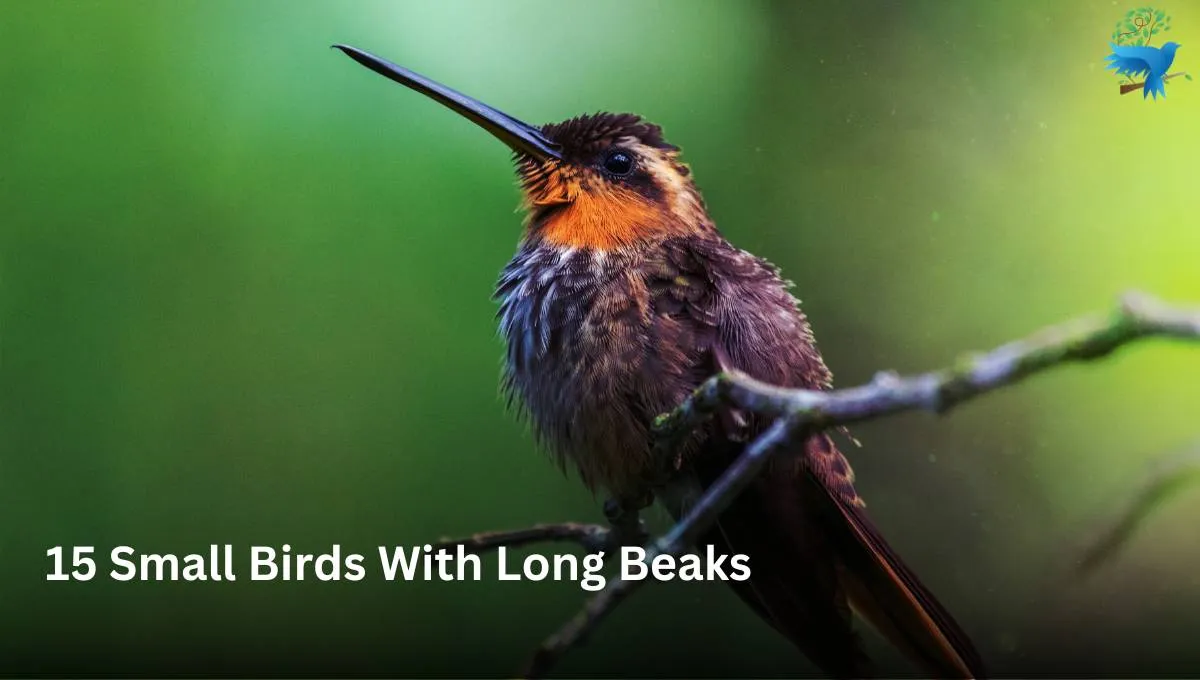
These small birds with long beaks can be found all over the world. These charming birds are distinguished by their extended bills and renowned for their inquisitive nature.
In the following blog post, we will be exploring about 15 types of small birds with long beaks in detail. Stick with us til the end of this article.
List of 15 Small Birds With Long Beaks
- American Avocet
- Long-billed Curlew
- Black-necked Stilt
- American Woodcock
- Common Snipe
- Northern Flicker
- Pileated Woodpecker
- Yellow-bellied Sapsucker
- Roseate Spoonbill
- Anna’s Hummingbird
- Allen’s Hummingbird
- Black-chinned Hummingbird
1. American Avocet (Recurvirostra americana)
The family of Recurvirostridae, American Avocet is recognized by its slender legs, slightly webbed feet, and a bill that is pointed, black, and slightly upwards curved towards the tip. This type of bird is a large wader in the avocet and stilt family.
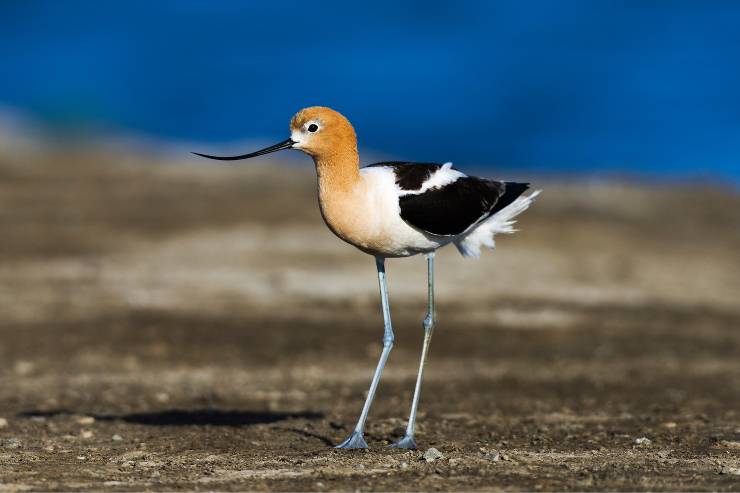
Size, Weight, and Wingspan of American Avocet:
- Size: 16–20 inches (40–51 cm)
- Weight: 9.7–14.8 ounces (275–420 g)
- Wingspan: 27–30 inches (68–76 cm)
Habitat: The American Avocet is commonly found in the shallow wetlands across the mid-western United States and as far north as Southern Canada.
Previously, these birds were found in most parts of the United States. But, American avocets are extinct from the East Coast.
Feeding:This type of species mainly feeds on brine shrimp during the winter season. Primarily, the American avocet feeding method is by pecking at flies. Besides this, the birds also feed by plunging, snatching, and bill pursuit.
2. Long-billed Curlew (Numenius americanus)
The North American shorebird, the Long-billed curlew is also known as candlestick bird and sicklebird.
Regarding their physical characteristic, the shorebird has a long neck, small heads, and curved bills, and the crown is streaked with brown.
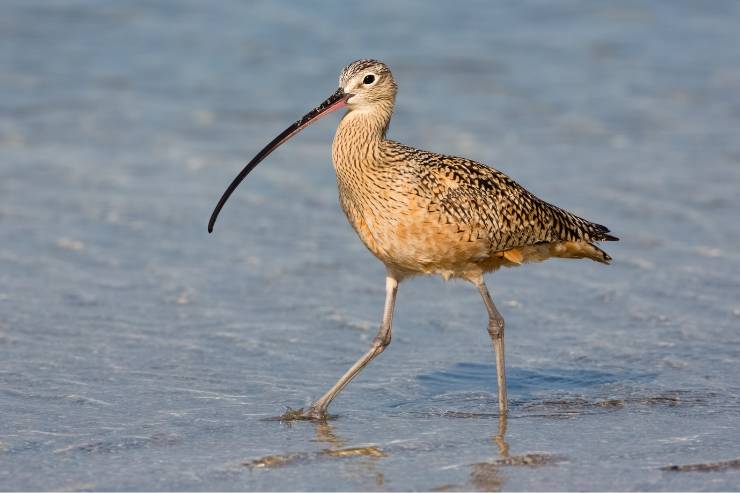
Size, Weight, and Wingspan of Long-billed Curlew:
- Size: 20–26 inches (50–65 cm)
- Weight: 24.5-35.5 inches (62–90 cm)
- Wingspan: 490–950 g
Habitat: The Long-billed curlew is a bird that is mainly found in central and western parts of North America. In the early 20th century, these bird species were practically extinct in San Francisco.
Feeding: Primarily, these birds often feed in flocks. With the help of a long bill, these fascinating birds probe for food in mudflats and grasslands.
Occasionally, the Long-billed curlew bird eats the eggs of other birds. Mostly, their food consists of crabs, grasshoppers, beetles, and other small invertebrate insects.
3. Black-necked Stilt (Himantopus mexicanus)
The black-necked stilt is a bird that has long pink legs, and a thin black bill. It is a black and white shorebird that has darker-colored dorsal feathers.
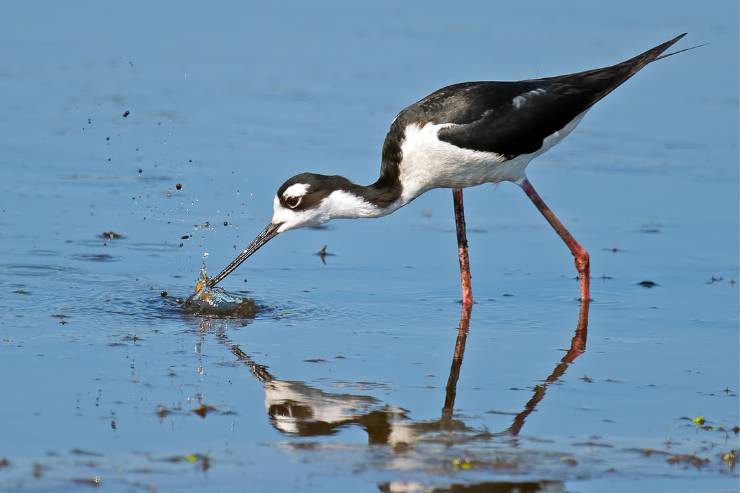
Size, Weight, and Wingspan of Black-necked Stilt:
- Size: 35–39 cm (13.8–15.3 inches)
- Weight: 150–180 g (5.3–6.2 ounces)
- Wingspan: 71–75 cm (28.1–29.7 inches)
Habitat: Commonly, the black-necked stilt is a lowland bird found in lacustrine, salt ponds, estuarine, and wetland habitats.
These birds are observed in the northern part of South America and during the summer and winter seasons in the coastal areas of California.
Feeding: Their diet mainly consists of aquatic invertebrates (such as crustaceans, and shrimp), arthropods (such as worms, and flies), and rare plant seeds.
The Black-necked Stilt forages are primarily found in the shallow waters near shores.
4. American Woodcock (Scolopax minor)
The American Woodcock is also known as the timberdoodle. This species is a kind of shorebird with a long rounded head, short legs, and a straight prehensile bill.
This bird uses their long bill to probe in the soil for food. In addition, Woodcock plumage is a cryptic mix of grays, brown, and black shades. Female woodcocks are larger in comparison to male woodcocks.
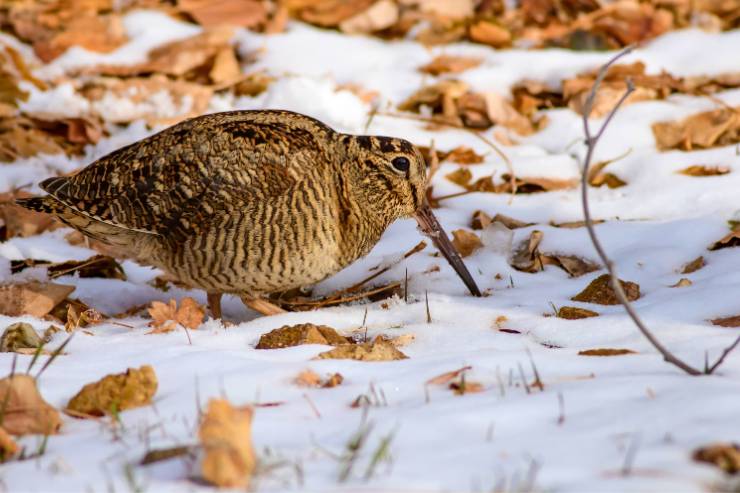
Size and Weight of American Woodcock:
- Size: 25 to 30 cm (10 to 12 inches)
- Weight: 140 to 230 g (5 to 8 ounces)
Habitat: Woodcock mainly live in moist woodlands and brushy areas. Primarily, the American Woodcock bird species are found in the eastern part of North America.
During the autumn season, they migrate south while in the winter season, most of the woodcocks travel in the Gulf Coast and southeastern Atlantic Coast states.
Feeding: The American Woodcock mainly eats invertebrates such as earthworms, centipedes, millipedes, spiders, ants, insect larvae, snipe flies, and beetles.
Woodcocks forage by probing in soft soil in thickets. Besides this, these birds also eat seeds.
5. Common Snipe (Gallinago gallinago)
Common Snipe scientific name is Gallinago gallinago. It is a small camouflaged bird that has unique characteristics to confuse its predators by flying in a series of aerial zig-zags.
These birds have long dark bills, short greenish-grey legs, and brown bodies with straw-yellow stripes on top. It also has vibrant pointed wings and a pale underneath.
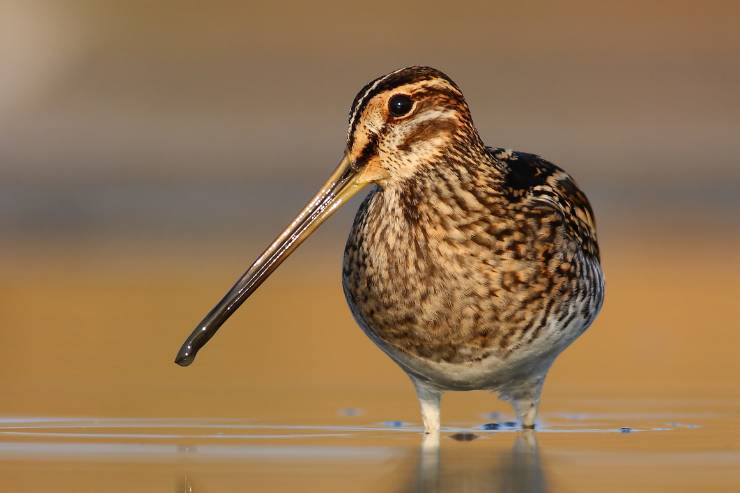
Size, Weight, and Wingspan of Common Snipe:
- Size: 9.8–10.6 inches (25–27 cm)
- Weight: 2.8–4.9 oz (80–140 g)
- Wingspan: 17–19 inches (44–47 cm)
Habitat: A stocky wader that belongs to the family of Scolopacidae is native to the Old World. They mainly reside in tundra, bogs, marshes, and wet meadows. These birds can also be observed in some parts of Asia.
Being a migratory bird, the common snipe is easily found in Berling Island, Kuril Island, the east coast of Taymyr Peninsula, central France, Northern Italy, and many more.
Feeding: These fascinating birds primarily consume insect larvae and earthworms. Along with that, they also eat some plant material.
Typically, this bird, Common Snipe is a shy bird that forages mostly in the soft mud, picking, or probing food by sight.
6. Northern Flicker (Colaptes auratus)
Northern Flicker is a medium-sized bird that is known to be a state bird of Alabama. It is also best known as Yellowhammer. Northern Flickers are only the species of a few woodpeckers that migrate from one part to another.
Adult male northern flickers can be easily distinguishable with a black or red mustachial stripe at the beak base. While the adult female northern flicker lacks this stripe.
Their plumage is variable, the upper breast has a necklace-like black patch. Likewise, the lower breast and belly have a beige color with black spots.
It also has a long slightly curved bill. As of now, it has been illustrated that the northern flicker life span is estimated to be seven years or more.
There are two species of northern flicker bird which has lived for at least 9 years 2 months old (Yellow-shafted northern flicker) and 8 years 9 months old (Red-shafted northern flicker).
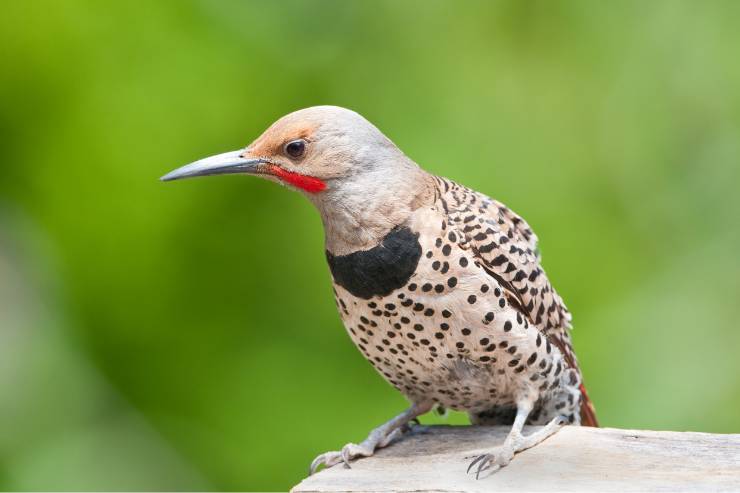
Size, Weight, and Wingspan of Northern Flicker:
- Size: 11–14 inches (28–36 cm)
- Weight: 3 to 5.88 ounces (86 to 167 g)
- Wingspan: 16.5-21.5 inches (42–54 cm)
Habitat: Northern Flickers live in open habitats such as yards, woodlands, parks, and edges.
They make a nest cavity, especially in homes of stucco and in trees like woodpeckers. These birds are native to North America, Cuba, Central America, Cayman Islands.
Feeding: Primarily, their main diet consists of insects like ants and beetles. Apart from this, they also consume berries, nuts, fruits, seeds, and invertebrates. Especially, the Northern Flicker catches insects from flight.
These species of birds eat ants which typically exhibit a behavior known as anting. With the help of this, they assist in preening to keep themselves safe from parasites.
An article published by Ibis has stated that in northern flicker nestlings, the coloration of feathers may be affected by the availability of food.
It revealed that it has a positive correlation with T-cell-mediated immune response and nestling quality.
7. Pileated Woodpecker (Dryocopus pileatus)
The pileated woodpecker is scientifically known as Dryocopus pileatus. It is a large-sized bird that is mainly black with a red crest. Both sexes can be easily identifiable.
With the presence of a red line that extended from bill to throat in the adult male pileated woodpecker. Whereas, the black line is present in the adult female pileated woodpecker.
Their bill size is measured from 1.6 to 2.4 inches (4.1 to 6.0 cm). The flight of these birds is direct and strong. It also has white wings at the time of flight.
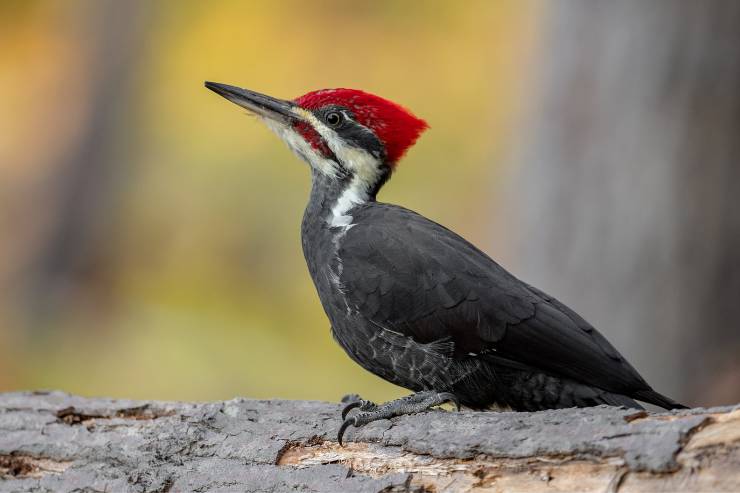
Size, Weight, and Wingspan of Pileated Woodpecker:
- Size: 16 to 19 inches (40 to 49 cm)
- Weight: 7.9 to 14.1 ounces (225 to 400 g)
- Wingspan: 26 to 30 inches (66 to 75 cm)
Habitat: Throughout the year, they habitat in forest areas, heavily wooded parks, and mature hardwood trees.
The pileated woodpecker is easily found in the eastern United States, the Pacific Coast, Canada, North America, and the Great Lakes. In the avian world, this bird is listed as the third largest species of woodpecker. You can attract pileated woodpecker by providing ants, beetles, and termites.
Feeding: It is an insectivore which mainly consumes insects. Such as wood-boring beetle larvae, carpenter ants, poison ivy berries, nuts, fruits, termites, and spruce budworms.
Most of the time this bird forages on the ground. Especially, near dead trees and fallen trees.
8. Yellow-bellied Sapsucker (Sphyrapicus varius)
The brilliant woodpecker has a short and straight chisel-tipped bill with a blackish slate in color. Overall, their crown is black-bordered and usually red.
Both male and female species of woodpecker are quite hard to distinguish. According to their throat and chin, they are easily identified with red color in males and white in females.
In adult males, the forehead is bright red, and a lighter shade of red in females. Their flight feather are black with white tips.
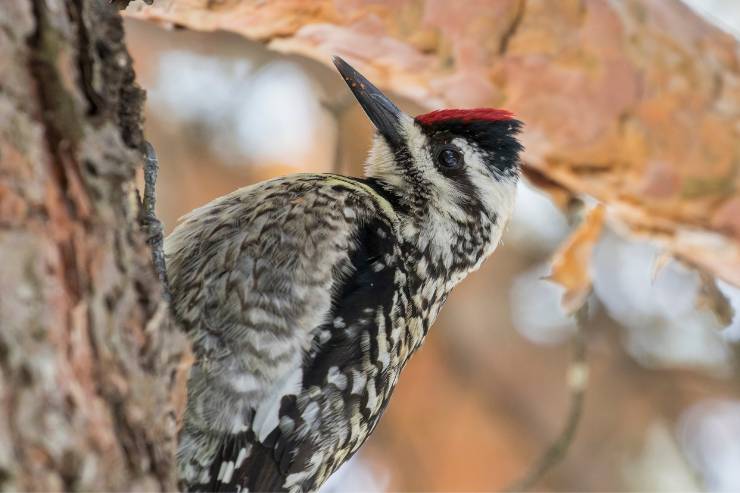
Size, Weight, and Wingspan of Yellow-bellied Sapsucker:
- Size: 7.5 to 8.03 inches (19 to 21 centimeters)
- Weight: 1.77 ounces (50.3 grams)
- Wingspan: 13.5 to 15.75 inches (34 to 40 centimetres)
Habitat: Generally, the breeding habitat is found in mixed coniferous forests and deciduous forests. Usually, this bird resides in open woodland, forest edges, and semi-open habitats.
It is a medium-sized woodpecker that is commonly found across the Northeastern United States, Canada, Central America, and Eastern Alaska. They are rare vagrant in Great Britain and Ireland.
Feeding: The yellow-bellied sapsucker usually feeds on insects. Besides this, these birds occasionally eat berries and buds during the spring season.
Throughout the year, they eat cambium which is extracted from the trees. From October to February, they consume fruits.
At the time of winter, they join a small group of flocks. While, occasionally the yellow-bellied sapsucker mixes into flocks of insectivores.
9. Roseate Spoonbill (Platalea ajaja)
A roseate spoonbill is a bird that has an elongated grey bill. This bird is known as a gregarious wading bird of the family, Threskiornithidae.
It also has a bare greenish head, white neck, breast, and back with a tuft of pink feathers.
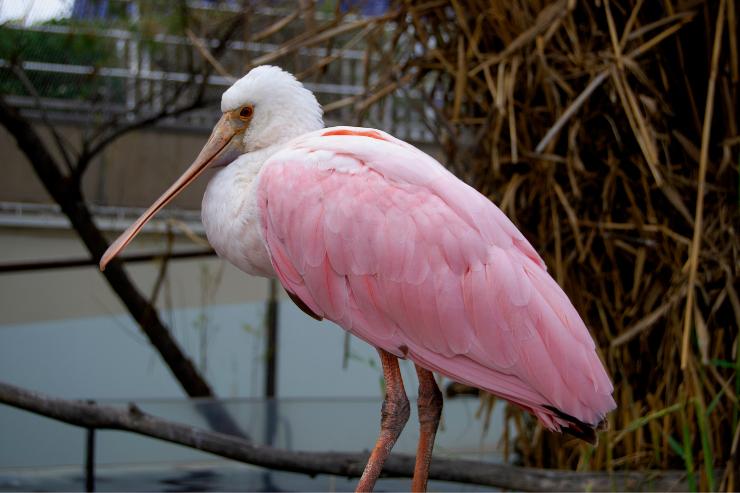
Size, Weight, and Wingspan of Roseate Spoonbill:
- Size: 28–34 inches (71–86 cm)
- Weight: 2.6–4.0 lbs (1.2–1.8 kg)
- Wingspan: 47–52 inches (120–133 cm)
Habitat: These brilliant birds are mostly found in Florida, Texas, Louisiana, the Caribbean, the Gulf Coast of the United States, Mexico, and the east Andes.
Feeding: This species of roseate spoonbill eats crustaceans, aquatic insects, mollusks, frogs, newts, and small fishes.
10. Anna’s Hummingbird (Calypte anna)
This small species of hummingbird has a relatively long, slender, and straight bill. With an iridescent bronze-green back, orange marks on the body, and a pale grey chest and belly.
The adult male has a striking crimson-red iridescent, a reddish-pink crown and gorget, and a slightly forked tail. Similarly, the adult female hummingbird has an iridescent red gorget.
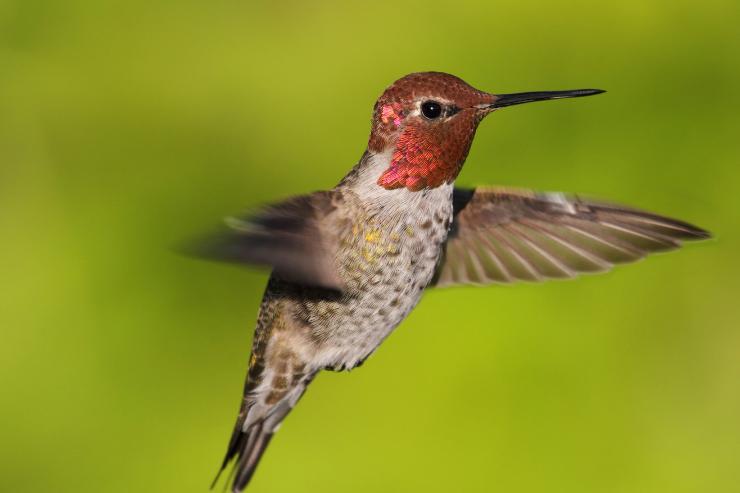
Size, Weight, and Wingspan of Anna’s Hummingbird:
- Size: 9.9 to 10.9 cm (3.9 to 4.3 inches)
- Weight: 2.8 to 5.7 g (0.1 to 0.2 ounces)
- Wingspan: 12 cm (4.7 inches)
Habitat: Particularly, Anna’s Hummingbird lives in a wider range across western Texas, the western coast of North America, central Arizona, and California.
Beyond these places, it is observed in New York, Louisiana, Florida, southern Alaska, and Newfoundland.
They are also found in open woods, gardens, chaparral, city parks, lower mountain slopes, and higher mountain meadows.
Feeding: These birds primarily feed on nectar from a wide variety of plants. Especially, Gooseberry and Currant.
11. Allen’s Hummingbird (Selasphorus sasin)
Overall, the adult male throat is an iridescent orange-red, green back and forehead with rufous flanks and rump.
Likewise, the female and immature hummingbirds are related to each other. Mostly, they are green in color.
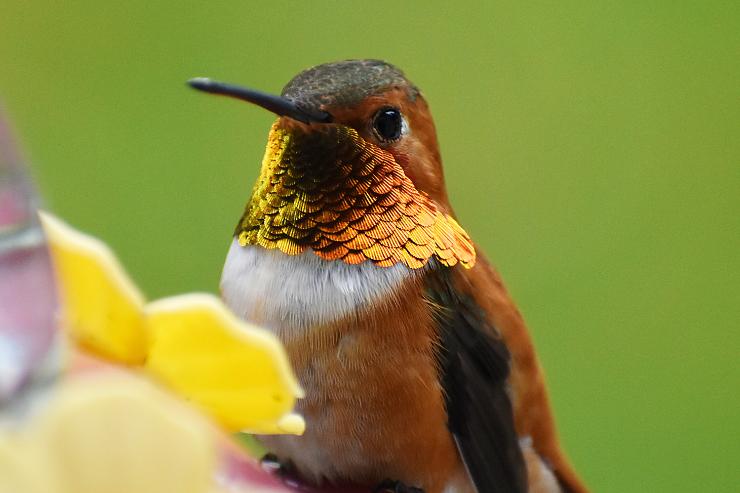
Size and Weight of Allen’s Hummingbird:
- Size: 7.6 to 8.9 cm (3 to 3.5 inches)
- Weight: 2 to 4 grams
Habitat: The Allen’s hummingbird is a species of hummingbird that belongs to the family of Trochilidae. Commonly, they are found in gardens, brushy woods, and meadows of coastal areas.
These birds mainly breed in the western part of the United States. Over the last five decades, the population of Allen’s hummingbird has decreased significantly by about 83%.
Feeding: This small hummingbird has a high rate of metabolism. The Allen’s hummingbird eats small types of insects like beetles, spiders, wasps, and flies.
Including this, it also feeds nectar from flowers. Such as paintbrush, red monkey-flower, and yellow blooms of tree-tobacco.
12. Black-chinned Hummingbird (Archilochus alexandri)
Black-chinned Hummingbird belongs to the family of Trochilidae. The loving bird has a black stripe on its throat. This type of species of hummingbird has a long, straight, and slender bill.
The adult male has a metallic green color in the upper part whereas the lower part has a white color below with green flanks.
Male hummingbirds have a glossy purple gorget and a dark forked tail. Similarly, a female hummingbird has a dark rounded tail with white tips. In like manner, a female has no patches on the throat and
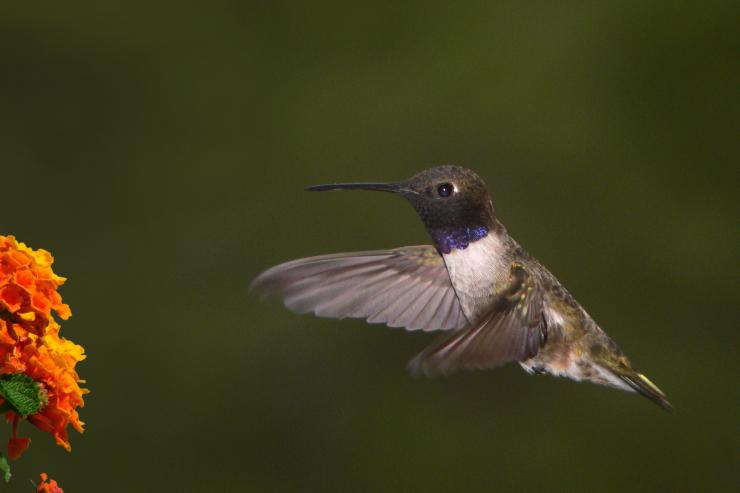
Habitat: Primarily, these Black-chinned Hummingbirds are found in most parts of the Western United States. That begins from north into Canada in Alberta, British Columbia, east to Oklahoma, and till the south of Mexico.
Commonly, these birds are found in woodlands, orchards, meadows, mountains, and chaparral habitats.
Feeding: Speaking about their feeding, Black-chinned Hummingbirds enjoy feeding on nectar from flowers with the help of their thin bill.
While collecting the nectar from the flowers, this bird also helps in plant pollination. With the help of a long tongue, they collect the nectar or catch the insects.
Conclusion:
In the avian world, numerous species of small birds exhibit elongated beaks. Each of the 15 species of small birds reflects their distinctive physical traits and colorful plumages.
These beautiful birds use their long beaks to catch their prey, adding to their charm and adaptability. Each species of bird has a different diet which mainly consists of insects, nectar, and small invertebrates.
This led to highlighting their ecological diversity and feeding preferences that play a vital role in the ecosystem.






